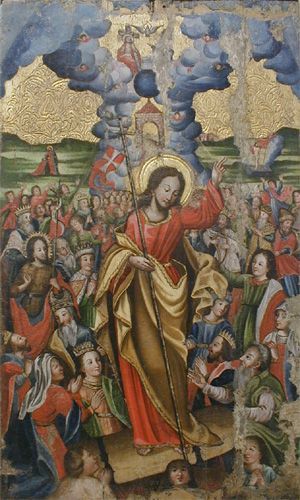
| Liturgical seasons |
|---|
|
Eastertide (also known as Eastertime or the Easter season) or Paschaltide (also known as Paschaltime or the Paschal season) is a festal season in the liturgical year of Christianity that focuses on celebrating the Resurrection of Jesus Christ. Preceded by Lent, it begins on Easter Sunday, which initiates Easter Week in Western Christianity, and Bright Week in Eastern Christianity.
There are several Eastertide customs across the Christian world, including flowering the cross,[1] sunrise services, the wearing of Easter bonnets by women,[2] exclaiming the Paschal greeting, clipping the church,[3] and decorating Easter eggs, a symbol of the empty tomb.[4][5][6] Additional Eastertide traditions include egg hunting, eating special Easter foods and watching Easter parades.[7][8] The Easter lily, a symbol of the resurrection in Christianity,[9][10] traditionally decorates the chancel area of churches on this day and for the rest of Eastertide.[11]
Traditionally lasting 40 days to commemorate the time the resurrected Jesus remained on earth before his Ascension, in some western churches Eastertide lasts 50 days to conclude on the day of Pentecost or Whitsunday.[12]
- ^ "The Flowering of the Cross". First Global Methodist Church of Forney. 19 March 2021. Retrieved 10 April 2023.
- ^ Friedman, Sally (27 March 2016). "Easter bonnets top at Burlington City shop". Burlington County Times. Retrieved 10 April 2023.
- ^ Simpson, Jacqueline; Roud, Steve (2003). "clipping the church". Oxford Reference. Oxford University Press. doi:10.1093/acref/9780198607663.001.0001. ISBN 9780198607663. Retrieved 30 March 2013.
- ^ Anne Jordan (5 April 2000). Christianity. Nelson Thornes.
Easter eggs are used as a Christian symbol to represent the empty tomb. The outside of the egg looks dead but inside there is new life, which is going to break out... Orthodox Christians dye boiled eggs red to make red Easter eggs that represent the blood of Christ shed for the sins of the world.
- ^ The Guardian, Volume 29. H. Harbaugh. 1878.
Just so, on that first Easter morning, Jesus came to life and walked out of the tomb, and left it, as it were, an empty shell. Just so, too, when the Christian dies, the body is left in the grave, an empty shell, but the soul takes wings and flies away to be with God. Thus you see that though an egg seems to be as dead as a stone, yet it really has life in it; and also it is like Christ's dead body, which was raised to life again. This is the reason we use eggs on Easter.
- ^ Gordon Geddes, Jane Griffiths (22 January 2002). Christian belief and practice. Heinemann. ISBN 9780435306915.
Red eggs are given to Orthodox Christians after the Easter Liturgy. They crack their eggs against each other's. The cracking of the eggs symbolizes a wish to break away from the bonds of sin and misery and enter the new life issuing from Christ's resurrection.
- ^ Vicki K. Black (1 July 2004). The Church Standard, Volume 74. Church Publishing, Inc. ISBN 9780819225757.
In parts of Europe, the eggs were dyed red and were then cracked together when people exchanged Easter greetings. Many congregations today continue to have Easter egg hunts for the children after the services on Easter Day.
- ^ Davis, David (20 April 2014). "Easter Traditions Explained". CBS News. Retrieved 20 April 2014.
- ^ Collins, Cynthia (19 April 2014). "Easter Lily Tradition and History". The Guardian. Archived from the original on 17 August 2020. Retrieved 20 April 2014.
The Easter Lily is symbolic of the resurrection of Jesus Christ. Churches of all denominations, large and small, are filled with floral arrangements of these white flowers with their trumpet-like shape on Easter morning.
- ^ Schell, Stanley (1916). Easter Celebrations. Werner & Company. p. 84.
We associate the lily with Easter, as pre-eminently the symbol of the Resurrection.
- ^ Luther League Review: 1936–1937. Luther League of America. 1936. Archived from the original on 3 August 2020. Retrieved 20 June 2015.
- ^ "Ascension Day: Ascension of Our Lord".